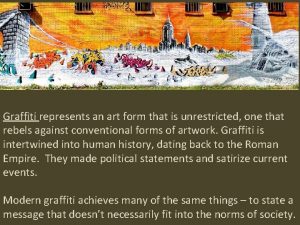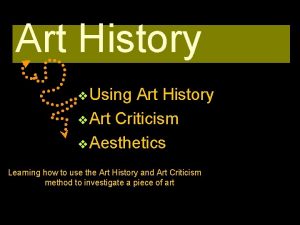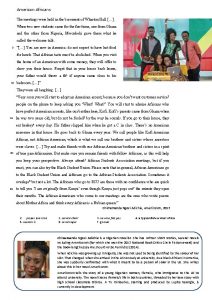Africans in European Art and History Africans were














- Slides: 14

Africans in European Art and History Africans were present in and participated in events outside of Africa--the history of Europe isn’t just a history of Europeans

Images of Africans in art of Ancient Eras Ancient Greece Ancient Egypt

Who was Saint Maurice? Saint Maurice--a. k. a. Moritz, Morris, or Mauritius--was a roman soldier, and a Christian, from Southern Egypt. He served in a Roman legion, all of whom were Christians from Southern Egypt. When they were ordered to attack Christians they refused, several times, and were all eventually sentenced to death.

Saint Maurice’s place in history The legendary Saint Maurice became a patron saint of the Holy Roman Emperors. In 926, Henry I (919 -936), even ceded the present Swiss canton of Aargau to the abbey, in return for Maurice's lance, sword and spurs. The sword and spurs of Saint Maurice were part of the regalia used at coronations of the Austro. Hungarian Emperors until 1916, and among the most important insignia of the imperial throne. Saint Maurice gives his name to the town St. Moritz. Statue of Saint Maurice, 1613, in Münster Cathedral, Germany. Over 650 religious foundations dedicated to Saint Maurice can be found in France and other European countries.

The African Diaspora in the Indian Ocean Chinese sailors and merchants had long made contacts with East Africans. We don’t known whether Africans traveled to China before the late 1400 s, but at that time they did so on Portuguese ships. Portuguese hired Africans as sailors and continued to do so for 200 years. Some Africans came to China this way. Africans also traveled aboard Portuguese ships to Japan. some of the African crewmen are depicted in Western attire in nanban byobu, Japanese paintings from the period of Portuguese contact. African men also served as soldiers. In 1622 about 100 Africans, along with another 100 residents, repelled the an attack by 13 Dutch ships and 1, 300 Dutch soldiers, on the Portuguese controlled port of Macau.

Africans traveled the Indian Ocean as interpreters Enslaved Africans were not only sailors, they served as interpreters as well. They spoke a variety of languages in addition to their own and Swahili. In addition, Swahili, with a Bantu grammar and many Arabic words, served as a ‘lingua franca’ for many enslaved Africans--a kind of bridge between the various linguistic and ethnic origins among captives in East Africa as well as those who crossed the Indian Ocean.

But in the Renaissance era, Africa and Africans were viewed in new ways and took on new roles in Europe “In the first half of the 1500 s, Africa became a focus of European attention as it had not been since the days of the “Africans participated in society in a great range of roles from Roman Empire. The European thirst for new markets drove visiting ambassador to cleric, writer, soldier, peasant farmer a consolidation of the trading routes established by to house slave. While many can be identified, the names of Portuguese explorers in the late 1490 s along the coasts of the great majority of slaves and freed men and women are Africa and into the Indian Ocean. The expansion of the lost, their existence only inferred from their defined roles and Ottoman Turkish Empire in North Africa resulted in military the rare depictions by artists. Recognizing the traces of their and political conflicts with European interests in the existence, their agency and, where possible, achievements Mediterranean. These elements, along with the importation is a way of restoring their identities. ”(also from the guide to REVEALING THE of Africans purchased as slaves, primarily from West Africa, AFRICAN PRESENCE IN RENAISSANCE EUROPE an exhibition at the Walters Art Museum) resulted in an increased African presence in Europe. ” (from the guide to REVEALING THE AFRICAN PRESENCE IN RENAISSANCE EUROPE an exhibition at the Walters Art Museum)

A Commemorative medallion featuring the likeness of Alessandro de Medici The many portraits of this 16 th century Italian Renaissance figure, show his African heritage, but it is rarely, if ever, mentioned. Alessandro was born in 1510 to an African serving woman in the Medici household. Historians think his father was then-17 year old Cardinal Giulio de Medici who later became Pope Clement VII. Giulio was the nephew of Lorenzo the Magnificent. On being elected Pope in 1523, Cardinal Giulio was forced to relinquish the lordship of Florence but he arranged for then-13 year old Alessandro to take eventually take his place when Alessandro was older.

The ethnic make up of this Medici Prince makes him the first black head of state in the modern western world. Alessandro wielded great power as the first duke of Florence. He was the patron (sponsor) of some of the leading artists of the era and is one of the two Medici princes buried in the famous tomb by Michaelangelo. In 1534, when his father the Pope died, exiled opponents of the Medici family tried to overthrow Duke Alessandro. But the Holy Roman Emperor upheld Alessandro and showed his support for him by giving Alessandro his own illegitimate daughter, Margaret of Austria, as wife.

…and Alessandro was not alone. Peter Paul Rubens Four Studies of the Head of a Negro

African women also were part of European history and art: (btw: the pose, etc. of the next figure is a traditional pose for female figures in Western art of this period--not somehow related to the woman being African)

And in later centuries, Africans were still part of Europe’s culture-characters in its ‘story’. Unfortunately slavery eclipsed other roles that Africans played in that story.

…and this is just a small sample of images showing Africans were present and played a part in events and eras outside of Africa. A resource for this presentation and for further studies: the multiple volumes of Dominique de Menil’s book, The Image of the Black in Western Art. It’s original 5 volumes were created in the 1960 s, as a response to segregation in the United States. Now, with the first president of African descent in office, Menil’s work has been updated and expanded to present new editions of the 5 original books, as well as an additional 5 volumes.

Other resources: “REVEALING THE AFRICAN PRESENCE IN RENAISSANCE EUROPE” available online via the Walters Art Museum site. And, “The Black Face of Renaissance Europe” in the magazine History Today (May 21, 2013).
 Art emerging europe
Art emerging europe Hollywood africans
Hollywood africans The bantu capital city in zimbabwe was called _____.
The bantu capital city in zimbabwe was called _____. Henry hudson motives for exploration
Henry hudson motives for exploration Reasons for exploration 3 g's
Reasons for exploration 3 g's What are the 4 gs of exploration
What are the 4 gs of exploration How were european rulers guided by enlightenment thought
How were european rulers guided by enlightenment thought Future in the past continuous
Future in the past continuous Middle ages floral design
Middle ages floral design 1993 europa
1993 europa Baroque floral design history
Baroque floral design history Dbq rubric
Dbq rubric Byzantine floral design
Byzantine floral design Ap european history chapter 17
Ap european history chapter 17 Music history periods
Music history periods



























